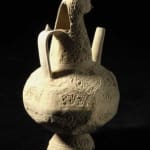Islamic Terracotta Vessel with the Head of a Bird, 8th Century CE - 10th Century CE
Terracotta
5.1 x 8.6
LO.1410
Ewer in the shape of a cockerel, buff earthenware with carved, moulded and incised decoration. Polygonal pear-shaped body on a medium-height splayed and decorated foot-ring; large medalions all over the...
Ewer in the shape of a cockerel, buff earthenware with carved, moulded and incised decoration. Polygonal pear-shaped body on a medium-height splayed and decorated foot-ring; large medalions all over the surface of the body, with blossoming rosettes and peaked floral motifs; tapering neck is entirely covered by scrollwork, terminating in a cockerel’s head; short flat handle with knob finial; small cylindrical spout on the shoulder .
These ewers were a very popular type of recipient and it has been a rather common practice for artists to delight prospective patrons by enlivening common vessels by means of attaching animal heads and other animal features. Such bird- and animal-shaped elements had been a common feature of metalwork ewers since the beginning of the Islamic period and numerous examples similar to this one, dated or datable from the 12th through the 14th century, have survived, based on their immediate precedents, silver ewers from Sasanian Iran and high-fired ceramics from the Tang and Song periods in China. Syria, Abbasid period, 9th - 10th century.
These ewers were a very popular type of recipient and it has been a rather common practice for artists to delight prospective patrons by enlivening common vessels by means of attaching animal heads and other animal features. Such bird- and animal-shaped elements had been a common feature of metalwork ewers since the beginning of the Islamic period and numerous examples similar to this one, dated or datable from the 12th through the 14th century, have survived, based on their immediate precedents, silver ewers from Sasanian Iran and high-fired ceramics from the Tang and Song periods in China. Syria, Abbasid period, 9th - 10th century.



